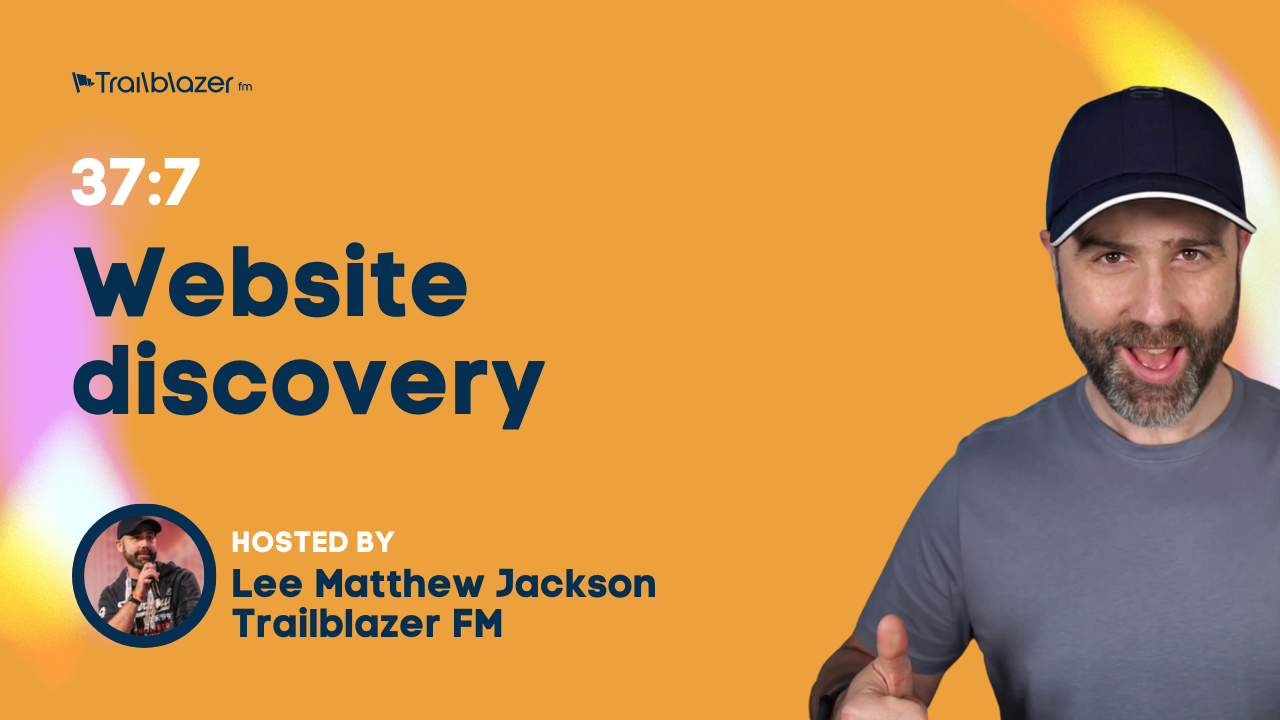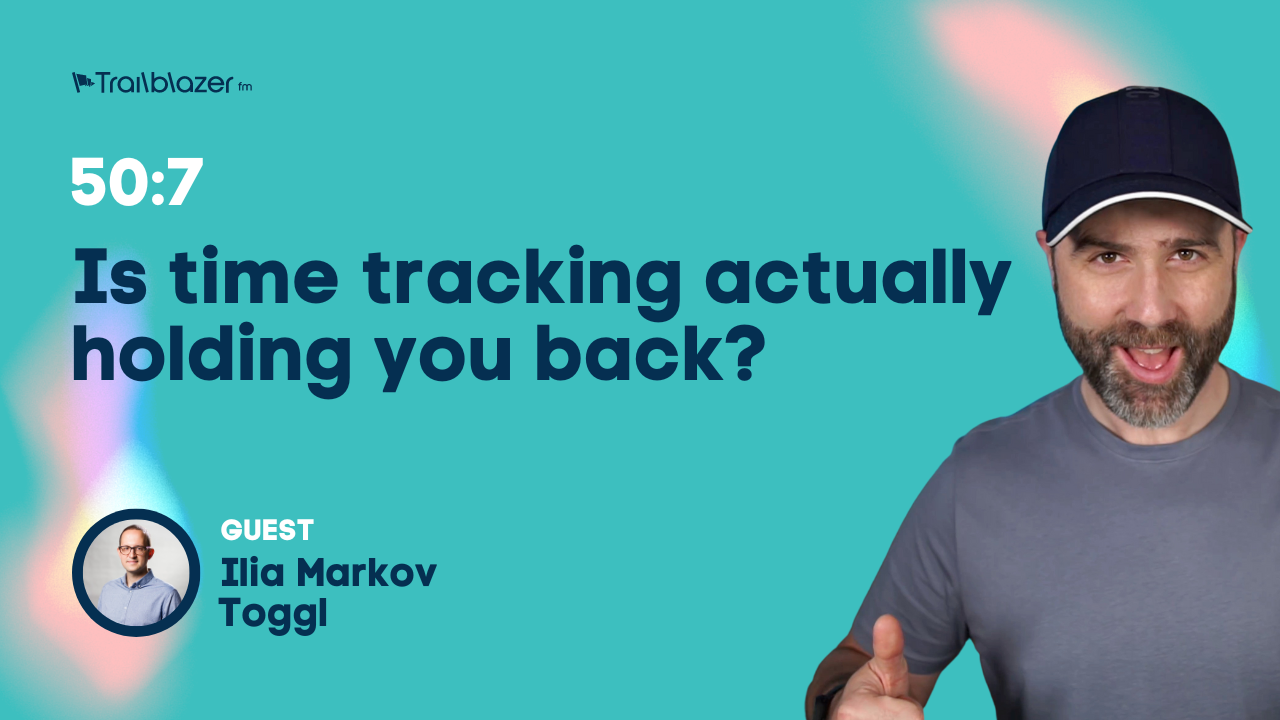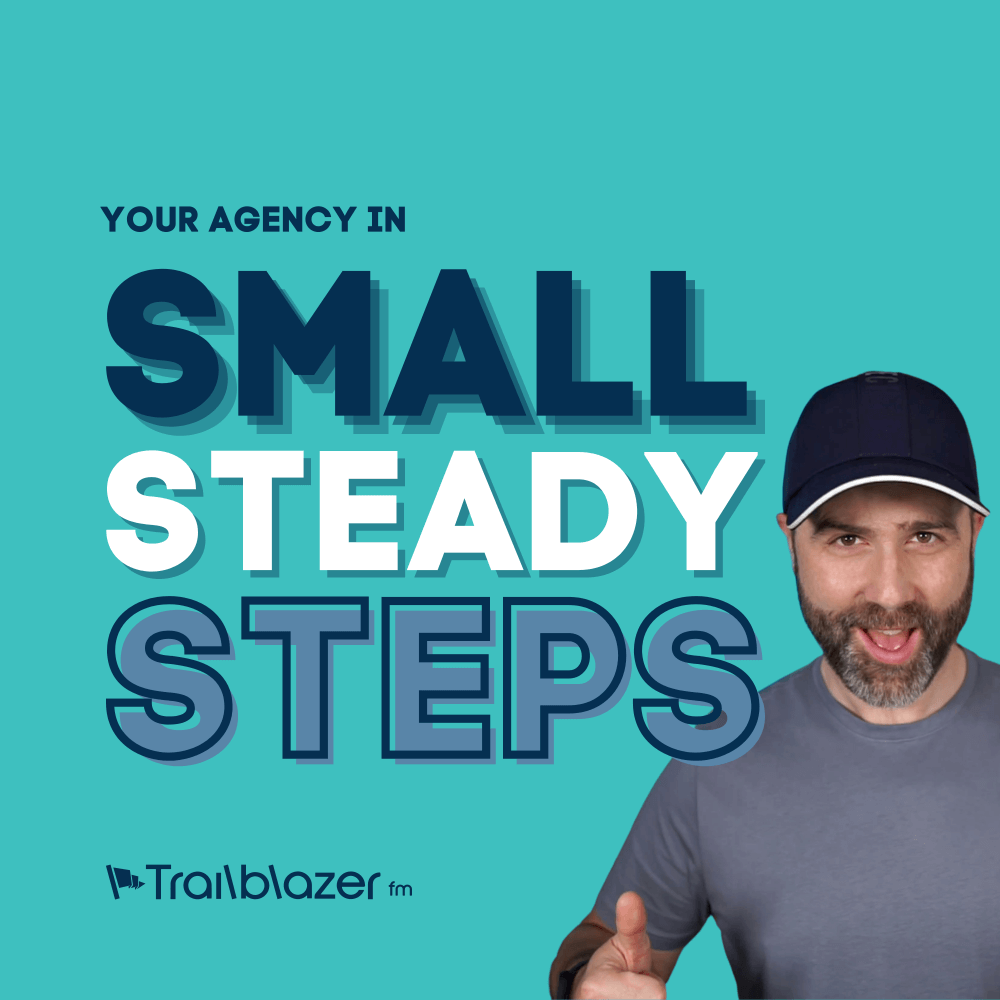
37:7 What to ask during website discovery
Ever wondered what questions to ask during a basic website discovery? Worried you might not capture everything you need to put together a winning proposal?
Ever wondered what questions to ask during a basic website discovery? Worried you might not capture everything you need to put together a winning proposal? In this episode I share the essential questions we use for our initial website discovery. This helps us to collate enough information to create an accurate reverse brief and to establish a reasonable budget.

Business discovery
- What does your business do and who do you do it for?
- What are your main pain points as a business?
- Where do you feel your biggest weaknesses are?
- Who is your target audience, and what do they need?
- Who are the people responsible for making project and spending decisions?
- Can the decision maker confirm the pain points listed are in fact the correct ones that the business should be focusing on?
Problem exploration
- Define the problem
- Review the data
- Understand the cause
- Establish the financial implication
- Brainstorm solutions
- Owners and deliverables
- How will we measure success
Budget
- What would your order of priority be if you were to tackle these problems one by one?
- What budget have you put aside for this project?
- What is the timeline for delivery you require?
Next steps
- Wrap up and set expectations
- Develop a reverse brief
- Send a proposal
- Close
Content upgrade
In order to charge the right price and to deliver your client’s dream website there are some essential questions you need to ask.
Grab your copy below or read more.
Transcript
Welcome to the Agency Trailblazer podcast, this is your host Lee and on today’s show, we ask the question, what should we ask during a website discovery session before we carry on?
I’d like to thank our wonderful sponsors Cloudways. They power hundreds of websites for our clients around the world, and they are our preferred cloud provider of choice. You can find out more information about Cloudways on cloudways.com.
Now then, have you ever wondered what questions to ask during a website discovery session? Many times I’ve been worried that I’m not going to capture all the information I need so I can put together that winning proposal. So I’d like to share with you in this episode the key questions that we ask.
This helps us to collate enough information for us so we can present an accurate reverse brief, put together a killer proposal, make sure that we hit that budget and of course, close the sale. All of the questions and the structure of this meeting is detailed in the episode and notes. You can find all of this over on trailblazer.fm or the link in the show notes on your podcast player.
We break down our discovery into four sections. First, we have business discovery. This helps us learn about the client and understand what makes them tick. Next, we go into the problem exploration. So that’s really getting under the hood of the problems that they have and brainstorming some solutions. Then we move through into the budget and then finally we wrap up with some next steps.
Let’s start with business discovery and our first question will be, what does your business do and who do you do it for? Now I would caveat that with you do need to do some research in advance and have an initial understanding. We would position that question with a very high level description of what we understand about their business and then ask them to expand upon it. So what does your business do and who do you do it for? It’s really important that we understand the problems that our clients solve and who they are solving those problems for. These are the very questions that we would ask of our own business. So it’s really important that we, too, are bought into the mission of our client.
Next, we’re going to ask what are the main pain points you have as a business? What are your main pain points as a business? So, for example, this could be generating leads. It could be getting more qualified leads. It could be onboarding new clients. There are all sorts of problems that your client may have, but it’s really good just to have that open discussion and find out what are those key pain points that your client needs to solve because they’re going to come in handy later on when we do some of that problem exploration.
Next, we move on to where do you feel your biggest weaknesses are? It’s really important, if we’ve understood their pain points, we need to understand their weaknesses because in many cases it’s their weaknesses that are feeding these pain points or these problems. An example might be their existing website. Perhaps they don’t have a good lead follow up process. Perhaps they feel their brand is just too weak, doesn’t do the job. It’s great to hear from the client where they feel their weaknesses lay.
The next question in the business discovery is, who is your target audience and what do they need? This is your opportunity to unpack the industry in more detail and perhaps establish one or two avatars of their client. There could be as simple as Jenny is, the procurement manager of a large real estate investment firm. She’s looking for construction businesses to apply for her RFP. Or perhaps Larissa is the operations manager of a large construction firm and she is looking for smaller firms to outsource some of those specialist projects to. These can be real simple avatars, but again, really help you to understand the problems, the needs of the target audience your client has.
Now that we have a better idea of what the business does and the people that it serves. We need to know a little bit more about how the business operates. So the next question is, who are the people responsible for making project and spending decisions? It’s super important that we understand if we have the right people in the room or whom we should be connecting with for those next stages.
All too often I’ve engaged in a discovery meeting with the wrong company representatives who only have half of the picture and essentially that makes everything we’ve done null and void. We can’t present a compelling proposal and ensure we’re solving the right problems if we are not speaking with the right people who have their finger on the pulse of the business.
So our follow up question here would be, can the decision maker confirm the pain points that have been listed out are in fact the correct ones? Are these what the business should be focusing on? I’m not saying that we need to drag the founder into the room, but I am saying, hey, we’ve established there are some pain points that you want to solve as a business. And can we get clarification from the right decision makers, from the business leaders, that these are the core problems, the core pain points, those main areas that you want to focus upon?
The next section is problem exploration. This is where we deep dive into those problems and this is a repeatable format. Essentially, we list out what are those key pain points of the business? What are those key problems that we are solving? For each one of those problems we define it, review it, understand the course, establish the financial implications. We brainstorm some solutions and we clarify how we’re going to measure success.
Let’s unpack each one of those. We define the problem as a clear sentence or short paragraph. For example, our website generates too many unqualified leads. Next, we will review the data and try to understand what is going on. Why are there current solutions not producing the results they need? For example, was there a specific time that these unqualified leads started to increase? Is there a particular channel that is responsible for these unqualified leads? Now, with this data, we look to understand the cause. So with our unqualifiedly problem, is it due to bad copy on the home page and unclear contact form, inappropriate Facebook, ad campaigns and so on?
Now we want to establish the financial implication of these problems not being solved, for example, time spent on those unqualified leads or perhaps a lack of those large contract inquiries that they are looking for. And it’s really helpful to try and quantify these. Can the client help us to quantify what sort of cost or financial impact this might be having? Assigning a monetary value to these problems really underlines the importance of resolving them.
The next step is to brainstorm at a high level with the client. We understand the problem. We understand the cause, we can see the monetary impact of that problem and we can start to unpack some solutions. Perhaps it could be updated website copy, perhaps we need better call to actions. Perhaps we should be putting in some better pre qualification questions into the contact forms. There are a whole range of ideas that we can throw into. A mix to help solve each and every problem, the end result is a range of ideas that we can assign some deliverables to and owners. It could be a brand new website. It could be a new brand. It could be the evolution of an existing website. Whatever those are, we can write those out as deliverables and understand who is going to own that delivery. A combination of ourselves and key people within the client’s business.
Finally, for each problem will agree some metrics for the measurement of success. What are we going to be measuring to see if the implemented solution is having that desired effect? For example, in the case of a form, it’s reviewing the data after, say, three to six months and seeing the scoring of those leads, as well as the conversions after the implementation, perhaps even the monetary value of those conversions.
So far we have learnt about the business. We’ve unpacked the problem, we’ve brainstormed solutions. We’ve said how we’re going to measure that success. So now we talk with the client about budget. And our next question is going to be, what would your order of priority be if we were to tackle all of these problems one by one? If there is no clear one obvious item that needs tackling first, then try and get the client to at least grade each problem in order of importance. This ensures that we tackle the problems in the right order. But also, if the client wants to test the relationship first, then we can use this as a way to tackle, say, one or two problems for them and help them get results. This is also useful if they don’t necessarily have the budget to tackle absolutely everything in one hit. But we can at least focus on those real key issues they need to resolve.
Next, we ask, what budget has the client put aside for this project? We will use the financial implications that we unpacked earlier during each of the problems to help our client understand the importance of investing in a solution that is going to solve these problems. Following on from this, we ask the all important timeline question what is the timeline for delivery that the client requires? This is going to help us to understand the urgency of the project and also how much resource we might have to throw at this.
The final section of discovery is those all important next steps. We’ll wrap up the meeting and explain that will be going away, writing up all of our notes from the discovery session to form a reverse brief. We’re also going to be providing them with a broken down estimate of budgets that they should be considering if they would like to work with us. Next, what we’ll do is site create the reverse brief based on the information that we have gathered. And that’s based on all of those questions that we’ve asked. That reverse brief will then be presented alongside a proposal that we will put forward that will break down the costs of resolving each and every one of those problems.
We tend to like to break those down into Sprints so that our client can easily understand what it is we will be doing, the impact of what we will be doing and how that correlates with the problems that they wanted to solve. The end result is a proposal you can present to your client that really captures what it is they are looking to achieve at a price or in a format that is financially achievable.
These discovery sessions only scratch the surface. So part of our proposal is to engage in a deeper discovery process where we deep dive into exactly how we are going to build and deliver each one of the solutions that we’ve recommended. We also highlight that the price or the overall budgets that have been set may be subject to change depending on what comes out from those exercises. It may be for certain projects you don’t need to go that far into such granular detail, but we would always, always recommend that you do some form of due diligence before entering into a build. Have all of the features clearly documented and agreed in writing before you begin development.
If you are working on one of those larger, more complex projects and you’re looking for a framework for your discovery, then we have launched the Trailblazer Project Discovery Blueprint you can find that over on trailblazer.fm/pdb or check out the link in the show notes.
As we come in to land, let’s do the recap. We started off with business discovery and asked the question, what does your business do and who do you do it for? We moved on into establishing what the pain points of the business were. Then we got our client to list out the biggest weaknesses. We then looked at their target audience and developed those relevant avatars and really impact what it is that they needed. We established who the people responsible for making project and spending decisions were, and then we clarified all of those pain points with them to ensure that these were the key areas that the business was looking to focus on.
Next, we moved into a repeatable process where we defined the problems, and for each one we reviewed the data to work out what was going on. With that, we started to understand potential causes. We looked at the financial implications of those problems. We brainstormed at a high level some solutions for each one of those problems. We defined some deliverables and some ownership to those deliverables and confirmed how we would be able to measure the success of each and every one of those solutions.
Next, we moved in to the budget and we asked what order of priority we should be tackling each one of these problems. Then we looked at what budget the client might have put aside using the financial implications that we’d unpacked during each one of those problems to help our client understand the importance of investing in a solution that’s going to help them solve those problems.
And finally, we looked at the timeline for delivery. Our final stage was the next steps where we set their expectations and explained what we were going to do and then we followed up by doing it, which was providing them with a phenomenal reverse brief and proposal that really captures the essence of what they are trying to achieve in a format and at a price that they could achieve it.
Folks, remember all of these are in the show notes over on trailblazer.fm. If you are looking to deep dive into Project Discovery for the more complex builds, then check out trailblazer.fm/pdb or check the show notes for the link to the Trailblazer Project Discovery Blueprint.
If you are not part of our Facebook group, do check it out over on trailblazer.fm/group. If we don’t see you in our Facebook group, then we will see you in next week’s episode.








